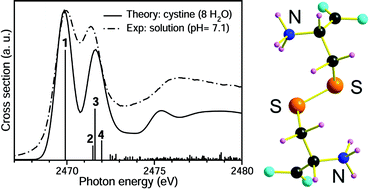Theoretical and experimental sulfur K-edge X-ray absorption spectroscopic study of cysteine, cystine, homocysteine, penicillamine, methionine and methionine sulfoxide†
Abstract
The experimental sulfur K-edge

* Corresponding authors
a
Department of Physical, Inorganic and Structural Chemistry, Stockholm University, Stockholm, Sweden
E-mail:
magnuss@fos.su.se
b Department of Chemistry, University of Calgary, Calgary, AB, Canada
c Department of Physics, Alba Nova, Stockholm University, Stockholm, Sweden
The experimental sulfur K-edge

 Please wait while we load your content...
Something went wrong. Try again?
Please wait while we load your content...
Something went wrong. Try again?
E. D. Risberg, F. Jalilehvand, B. O. Leung, L. G. M. Pettersson and M. Sandström, Dalton Trans., 2009, 3542 DOI: 10.1039/B819257J
To request permission to reproduce material from this article, please go to the Copyright Clearance Center request page.
If you are an author contributing to an RSC publication, you do not need to request permission provided correct acknowledgement is given.
If you are the author of this article, you do not need to request permission to reproduce figures and diagrams provided correct acknowledgement is given. If you want to reproduce the whole article in a third-party publication (excluding your thesis/dissertation for which permission is not required) please go to the Copyright Clearance Center request page.
Read more about how to correctly acknowledge RSC content.
 Fetching data from CrossRef.
Fetching data from CrossRef.
This may take some time to load.
Loading related content
